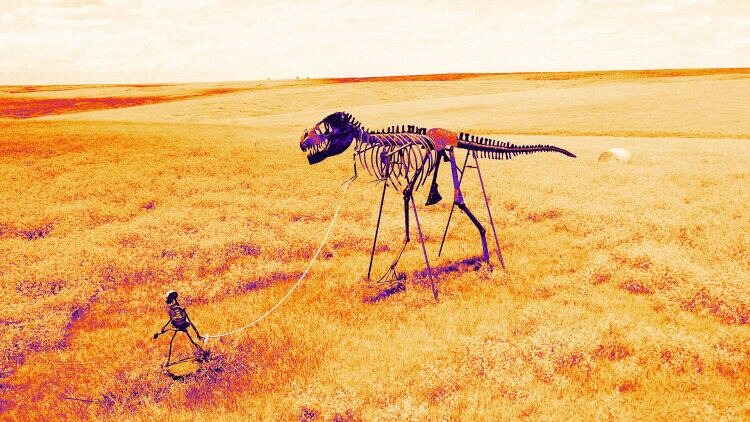- | 8:00 am
Museums shouldn’t be fighting with billionaires over extinct species
We need to create a new era wherein society can creatively reconcile the desires of the wealthy and the needs of the masses.

Dinosaurs may not be roaming the earth, but dinosaur obsessives are very much alive and have been stomping around the Sotheby’s auction house. On July 17th, the 11-foot-tall skeleton of a Stegosaurus nicknamed “Apex”—which was estimated to bring a piddling $4 million to $6 million dollars—was gaveled down at an eye-watering $45 million.
This was a historical prehistorical event, the most ever recorded for a dinosaur fossil. It was also highly controversial. There has been an ongoing debate about the existential nature of ownership, pitting those who believe that artifacts of this sort should be kept in museums(and the rightful museum-country, native to the artifact)—where they are available to the public—against others who maintain that the free market should have its way.
Should museums be investing in what some might call vanity trophies, like Apex? Are their acquisition budgets—funded by the largesse of donors, ticket prices, and gift-shop margins—best focused on lopsided investments like paleontology? Or are there higher-impact opportunities, both in terms of acquisitions and community programming, which deserve those funds? That is a profound question that matters to many in the museum and academic communities.
That “many” includes me. As CEO of COSI, one of America’s leading science museums, you would expect me to have a perspective on this.
The first point I want to make is that this needs to be a nuanced conversation, and I stand against the weaponization of arguments for larger ideological aims. That includes the bashing of billionaire acquirers like Ken Griffin, CEO of the giant hedge fund Citadel, who now can serve The Jurassic Fizz in the same room as the looming presence of Apex. And by the way, this has nothing to do with the fact that Mr. Griffin donated $125 million to the Museum of Science and Industry—their largest donation ever in their 90-year history, though I applaud the impactful generosity.
There is, in fact, a long history of wealthy individuals buying art and removing it—at least temporarily—from public view. J.P. Morgan controversially bought the medieval Lindau Gospels, an illuminated manuscript, in 1901. Financier Leon Black bought Munch’s The Scream in 2012, and Steven Cohen now owns Picasso La Rêve.
Let it be noted that Morgan’s son donated the Lindau masterpiece to the eponymous Morgan Library, and in fact one argument is that most of these extraordinary works will end up available to museumgoers. This is what happens when the natural human instinct for the wealthy to show off their prizes—their Veblen goods—becomes less operative, either when the original purchaser passes on, or “trophy fatigue” sets in. In fact, the top museums in the world owe much of their vaunted collections—both on exhibit and in storage—to the generosity and vision of the private wealthy collectors.
As a paleontological example, I bring you Stan, a T. rex that was sold to an anonymous buyer, setting the previous auction record for $31.8 million, and will end up in Abu Dhabi’s Natural History Museum when it opens in 2025.
I must also make the point, clearly and bluntly, that perhaps museums have better things to spend their money on, than fossils. In Columbus, Ohio, where COSI is located, our students score below 25% in mathematics proficiency at despondent levels of 16% in elementary school, 13% in middle school, and 10% in high school. Similar numbers can be found in urban and rural communities throughout the nation.
Our district only spends $9 million on instruction. That is 20% percent of what Apex cost. If I had $45 million to bring the stegosaurus to my city, would I have spent it on a dinosaur—as majestic and inspiring as it is—when I could use that money to create outreach programs to inspire young people about what science can mean to them?
I think you know the answer.
I also need to ask whether in today’s world, where precision 3-D modeling can create extremely accurate replicas of fossils and art, a replica of Apex is an equally stunning and inspiring way to introduce children and adults to the history of our planet? It certainly is a more economically sane approach, one that would allow their available museum funds to have a more profound impact on education and our shared future.
At the same time, I have a message for my colleagues in the museum world, and in academia, who believe that our shared cultural heritage should be immediately and forever accessible. If that is your mission, then I encourage you to wake up. Move faster and abandon your layered bureaucracy when opportunities like Apex present themselves.
A useful comparative is NASA, and Space X and Blue Origin. Museums, like NASA—who had a monopoly on space—are always complaining there is “never enough money” to do all of the things they want to. Then Elon Musk and Jeff Bezos came along, and opened up space exploration in a way that is faster and bigger (and still as safe) as what NASA could accomplish.
If museums acted and behaved more like the entrepreneurial space startups, they would be in a far better position to compete for the acquisitions they seek. My world can certainly learn from their world.
And there is more to it than that. The old way was either/or. The new way must be and. Cultural institutions should be partnering more with private donors, creating a new era of “co-bidding,” ultimately affording a new wider aperture for showing the prize and doing research around it.
The scientists tell us Apex had a touch of arthritis before he became preserved forever. Let us elevate our discussion beyond the fossilized, zero-sum game of the past and create a new era wherein society can creatively reconcile the desires of the wealthy and the needs of the masses.






































